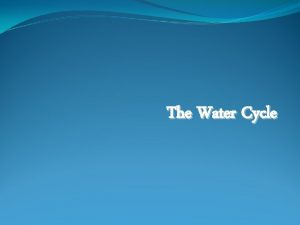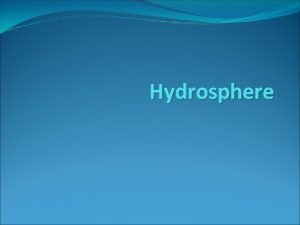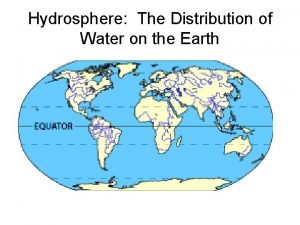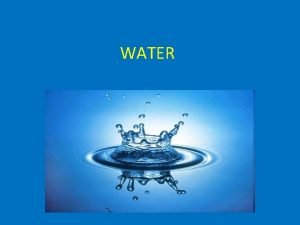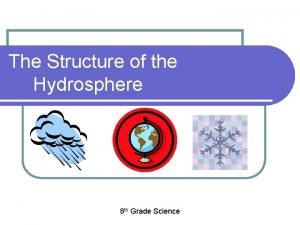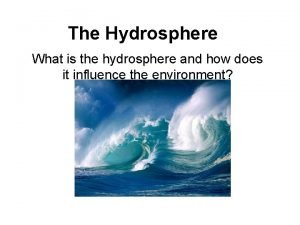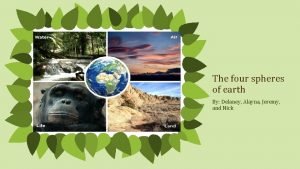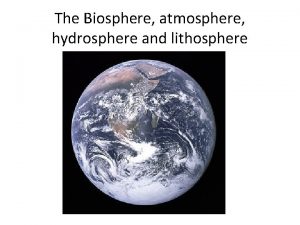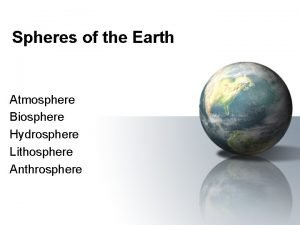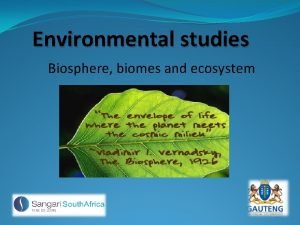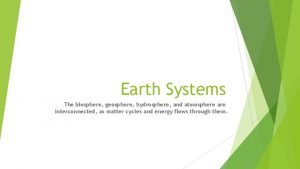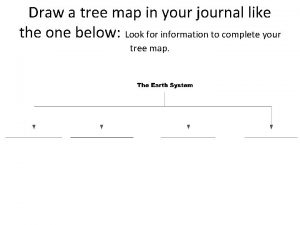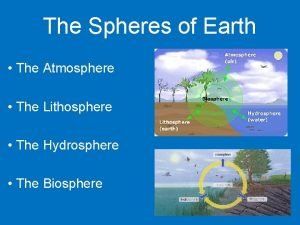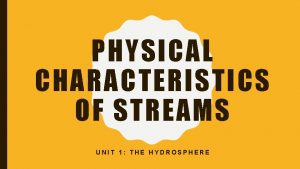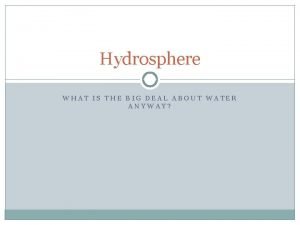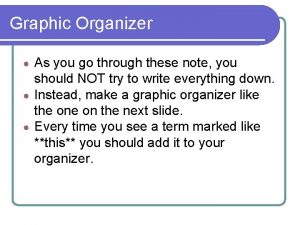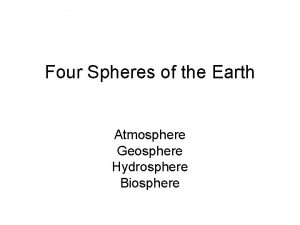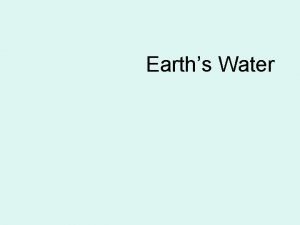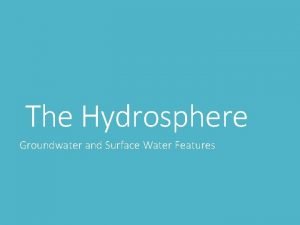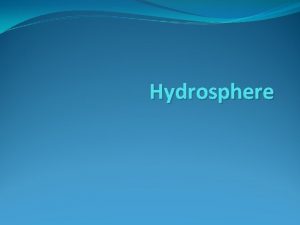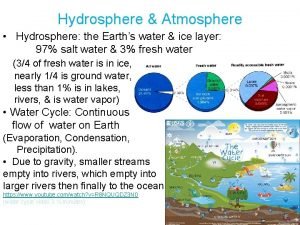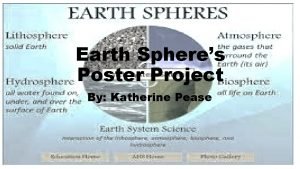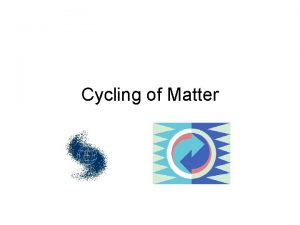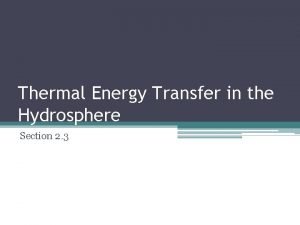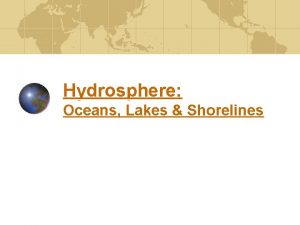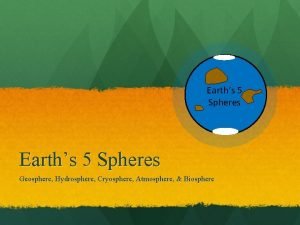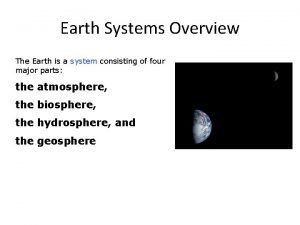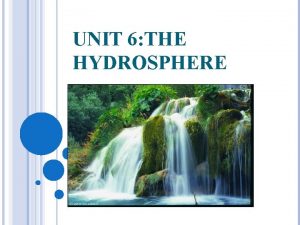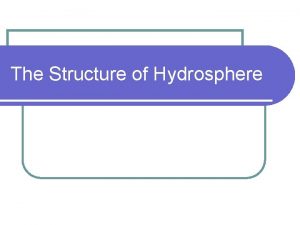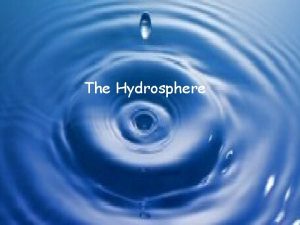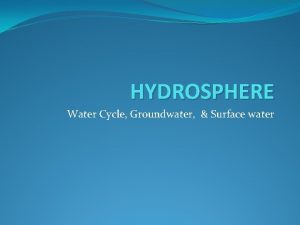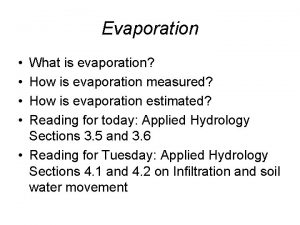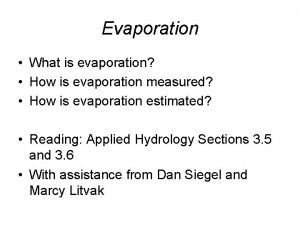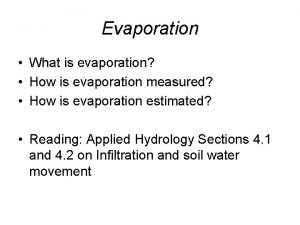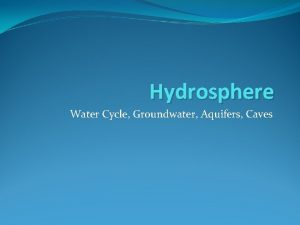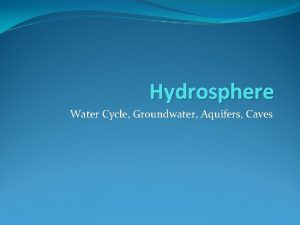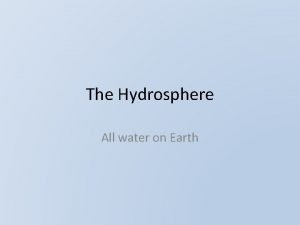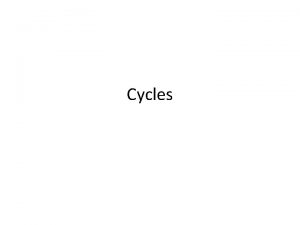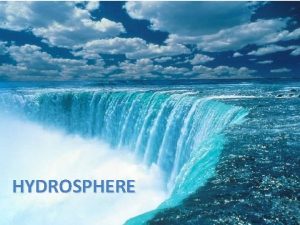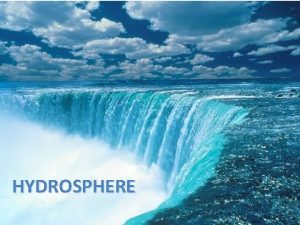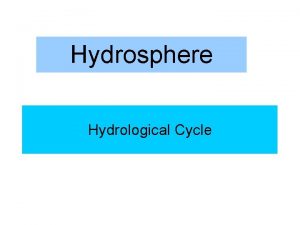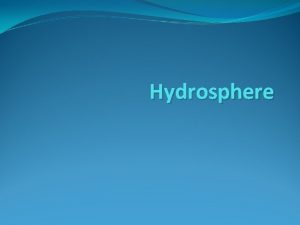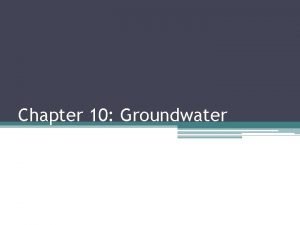Hydrosphere Water of the Earth Water Cycle Evaporation











































- Slides: 43

Hydrosphere Water of the Earth!!


Water Cycle


Evaporation – liquid water changes into water vapor. (apply heat) p. 1

Transpiration – where plants give off water vapor p. 1

Evapotranspiration p. 1 • evaporation + transpiration in one word

Sublimation – solid straight to gas p. 1 • Solids that are introduced to high heat over a short period of time can skip the liquid phase. Typical phase change Solid → Liquid → Gas Sublimation Solid → Gas

Condensation – when water vapor rises into the atmosphere it cools, then forms clouds. p. 2

Condensation leads To Precipitation p. 2 • Rain, sleet, snow: any form of water falling to earth.

Water Storage on Earth p. 2 • • • Ice Caps Snow Oceans Lakes Ground Water

Water Budget p. 3 • The continuous cycle of evapotranspiration, condensing, and precipitation gives us the earth’s water budget. • Usually is balanced for any given area. • World Water Budget is not balanced. What might be some reasons why?


Local Water Budgets • Rain forest • Desert • Michigan

Some places are losing fresh water.


Water Conservation What Can We Do? • Great Lakes – Water Losses • Be Involved – vote for laws to save our Great Lakes.

Bottled Water • Empty your bottles before you throw them away! • Plastic Does Not break down in a landfill! That water is locked up forever.

Lower Consumption • • • Install water conserving toilets Less watering of lawns Shorter showers Fix leaks Turn off water when Brushing teeth

Government Help

Human Impact

Quiz

13. 2 River Systems • Tributaries – feeder streams to river system • Water shed – drainage basin • Divides – elevated ground to separate water sheds • Gully – narrow ditch • Runoff – water that is not soaked into soil

Watershed

Mississippi River Water Shed


Great Lakes

Stream Erosion • Channel – path the steam follows • Headward erosion – process of lengthening and branching of stream • Stream piracy – capturing water from other water sheds through erosion

Erosion

Channel Erosion • banks – edges of stream channel above water • Bed – part of the stream below water level • Stream Loads – materials carried by stream including water, soil, rocks, minerals • Loads: • 1. Suspended - fine and silt (floating by speed, velocity) • 2. Bed – coarse sand, gravel, pebbles (slides and rolls) • Saltation – short jumps • 3. Dissolved - TDS

Discharge and Gradient • Discharge – volume of water moved by stream • Gradient – steepness of its slope • Velocity – speed of stream • Headwaters - beginning

Niagra Falls

Frozen Niagra Falls

Water and Wind Gaps • Water gap – erosion of earth rising causes water to need to go uphill • Ex. Delaware water gap • Wind gap – notch created where water can no longer pass

Stages of a River System • Youthful rivers – rapid erosion of bed, v-shaped valley, steep banks, waterfalls and rapids, few tributaries, less water • Mature rivers – well established tributaries, erosion of banks, low gradient, meanders forming, oxbow lake • Old rivers – lower gradient, slower, more meaders, fewer tributaries, little erosion, deposits sediments • Rejuvenated rivers – gradient of stream becomes steeper resulting in steplike terraces (Miss. River, Tequm lower falls)

Assignment • Pg. 251 #1 -5

13. 3 Stream Deposition • • rocks Stones Pebbles Gravel Course sand Fine sand silt

Deltas and Alluvial Fans • Greatest deposition at area stream dumps into large body of water • Delta – fan shaped deposit at mouth of river • Alluvial fan – load causing flatten out after a step slope • 1. sediments on dry ground, delta wet • 2. coarse sand gravel, delta mud • 3. sloped whereas delta flat

Flood Deposits • Floodplain – deposits of silt and sand • Springtime - ^with snowmelt v evapotranspiration • Ice jams • Natural levees – deposits silt and sand

Flood Control • • • Indirect methods: 1. Forestation 2. Soil conservation to prevent runoff Direct methods: 1. dam (electric, irrigation, human conception and recreation) • 2. levees • 3. overflood channels

Assignment • Pg. 255 #1 -5 • Pg. 256 -57 #1 -12


 Evaporation water cycle
Evaporation water cycle Advantages of hydrosphere
Advantages of hydrosphere Hydrosphere water distribution
Hydrosphere water distribution Water and water and water water
Water and water and water water Water
Water Transpirasi yaitu penguapan air
Transpirasi yaitu penguapan air How is the carbon cycle similar to the water cycle brainpop
How is the carbon cycle similar to the water cycle brainpop Water cycle the hydrologic cycle
Water cycle the hydrologic cycle Tributary
Tributary Structure of the hydrosphere
Structure of the hydrosphere Hydrosphere images
Hydrosphere images Defenition of hydrosphere
Defenition of hydrosphere Biosphere
Biosphere How does biosphere interact with hydrosphere
How does biosphere interact with hydrosphere Hydrology study guide answer key
Hydrology study guide answer key How does biosphere interact with hydrosphere
How does biosphere interact with hydrosphere There are types of biomes
There are types of biomes Geosphere to biosphere
Geosphere to biosphere Hydrosphere concept map
Hydrosphere concept map Hydrosphere
Hydrosphere Characteristics of hydrosphere
Characteristics of hydrosphere Whats hydrosphere
Whats hydrosphere Hydrosphere mind map
Hydrosphere mind map Biosphere
Biosphere Three ways to conserve water
Three ways to conserve water Surface water features
Surface water features The hydrosphere includes
The hydrosphere includes Hydrosphere layer
Hydrosphere layer Earth sphere poster
Earth sphere poster Hydrosphere pictures
Hydrosphere pictures Thermal energy transfer
Thermal energy transfer Hydrosphere
Hydrosphere 5 spheres of earth
5 spheres of earth Hydrosphere
Hydrosphere Hát kết hợp bộ gõ cơ thể
Hát kết hợp bộ gõ cơ thể Frameset trong html5
Frameset trong html5 Bổ thể
Bổ thể Tỉ lệ cơ thể trẻ em
Tỉ lệ cơ thể trẻ em Chó sói
Chó sói Chụp phim tư thế worms-breton
Chụp phim tư thế worms-breton Chúa yêu trần thế
Chúa yêu trần thế Các môn thể thao bắt đầu bằng tiếng chạy
Các môn thể thao bắt đầu bằng tiếng chạy Thế nào là hệ số cao nhất
Thế nào là hệ số cao nhất Các châu lục và đại dương trên thế giới
Các châu lục và đại dương trên thế giới
